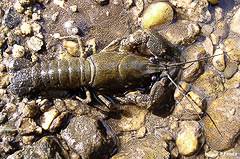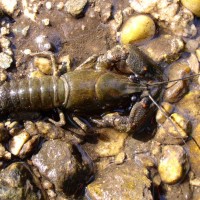
Noble Crayfish - Astacus astacus
Expand and collapse the sections below by clicking on the title or + / - icons.
Short description of Astacus astacus, Noble Crayfish
Adults grow slowly but may reach 15cm or more in length. They are variable in colour and range from shades of brown and beige, to bright red and occasionally blue. There are ridges on the carapace and spines on the shoulder of the carapace. Spines and absence of a white-turquoise patch on the claw differentiate the noble crayfish from the otherwise similar signal crayfish.
Impact summary: Astacus astacus, Noble Crayfish
Noble crayfish are omnivorous. They feed mainly on plants and so could have significant impacts on habitat structure and productivity, but will switch to higher trophic levels when necessary and so can have impacts across the food chain. Their burrowing activities could destabilise riverbanks and increase sedimentation. Crayfish could reduce productivity of commercial fishing by competing with fish for food and stealing baits, however, fisheries are limited within the current range of the noble crayfish.
Habitat summary: Astacus astacus, Noble Crayfish
The noble crayfish is found in freshwater habitats including rivers, streams, lakes, ponds and canals in its native range, and has colonised a river, streams and a pond in England.
Overview table
| Environment | Freshwater |
|---|---|
| Species status | Non-Native |
| Native range | Europe, Andorra, Austria, Bosnia-Herzegovina, Belgium, Bulgaria, Belarus, Czech Republic, Germany, Denmark, Estonia, Finland, France, Greece, Croatia, Hungary, Lithuania, Latvia, Moldova, Macedonia, Netherlands, Poland, Romania, Slovenia, Kosovo, Montenegro, Serbia |
| Functional type | Omnivore |
| Status in England | Non-Native |
| Status in Scotland | |
| Status in Wales | |
| Location of first record | |
| Date of first record | 1986 |
Origin
The noble crayfish is native to central and eastern Europe.
First Record
The noble crayfish was fist recorded in the River Chew, southwest England, in the 1980s.
Pathway and Method
The noble crayfish was introduced into England from Germany in the early 1980s for aquaculture. It is likely that crayfish were released from a farm in the 1980s into the River Chew and have since colonized streams within the catchment.
Species Status
The noble crayfish colonised much of Europe several centuries ago and is now found in 39 countries (including Greece, France and Scandinavia), many of which now consider it to be native. Since being introduced in the 1980s the noble crayfish has spread very slowly in England. Its range is still limited to the southwest, and there are only three or four viable populations still found within or near the River Chew catchment.
Dispersal Mechanisms
Ability to disperse appears limited, as populations have not spread far from their release point. They can move up and downstream, although by only 15m per day, and it is not known whether they will travel overland. There is potential for humans to cause spread through the pet trade, use of crayfish by anglers for bait and fish food, with fish transported between water bodies or perhaps naturally by predatory birds e.g. herons, however, noble crayfish appear to be one of the least invasive crayfish species to have reached GB.
Reproduction
Individuals grow slowly and have relatively low fecundity, with females producing 60-100 eggs at a time. Eggs normally take 9 months to develop, but developmental rate increases with temperature. Population growth rate is slow.
Known Predators/Herbivores
Aquatic predators such as heron, pike, eels and otters would feed on noble crayfish but their impact would not prevent establishment of a population. It is likely that spread of noble crayfish could be limited by competition with dominant signal crayfish. This could be in large part due to the susceptibility of noble crayfish to crayfish plague.
Resistant Stages
Noble crayfish can live in a wide range of freshwater habitats and can easily survive the temperature extremes of GB.
Habitat Occupied in GB
Populations are found in the main river and streams of the River Chew catchment, as well as an ornamental pond in Bristol.
Since being introduced in the 1980s the noble crayfish has spread very slowly in England. Its range is still limited to the southwest, and there are only three or four viable populations still found within or near the River Chew catchment.
Environmental Impact
Noble crayfish feed largely on plant material, and so could significantly impact macrophyte abundance and habitat structure. They will switch to an omnivorous diet if food becomes limited and so could affect food webs at several trophic levels. They could cause changes in turbidity and bank structure through burrowing. Noble crayfish do not carry crayfish plague so are of limited threat to the native white-clawed crayfish, although it is possible that the noble crayfish could outcompete the native crayfish for resources if ranges overlapped.
Health and Social Impact
None known.
Economic Impact
It is possible that noble crayfish may reduce the productivity of commercial fisheries by competing with fish for food, or stealing bait from lines. However, noble crayfish population sizes are limited and there are very few fisheries in the affected Chew catchment.
Identification
UK non-native organism risk assessment scheme. Version 3.3. Astacus astacus – Noble crayfish.
Biology, ecology, spread, vectors
Hessen, D.O. et al. (1987) Egg development and lifecycle timing in the noble crayfish (Astacus astacus), Aquaculture, 64, no. 1, 77–82.
Holdich, D.M. (2002) Distribution of crayfish in Europe and some adjoining countries, Bulletin Français de la Pêche et de la Pisciculture, 367, 611–650.
Hudina, S., Maguire, I. & Klobučar, G.I.V. (2008) Spatial dynamics of the noble crayfish (Astacus astacus, L.) in the Paklenica National Park, Knowledge and Management of Aquatic Ecosystems, 388, 1–1.
Management and impact
Axelsson, E. et al. (1997) Crayfish predation on amphibian eggs and larvae, Amphibia-Reptilia, 18, no. 3, 217–228.
Peay, S. (2009) Invasive non-indigenous crayfish species in Europe: Recommendations on managing them, Knowledge and Management of Aquatic Ecosystems, 394-395.
General
Gherardi, F. (2007) Understanding the impact of invasive crayfish, Biological invaders in inland waters: Profiles, distribution, and threats, 507–542.
Brickland, J., Holdich, D.M. & Imhoff, E.M. (eds) (2009) Crayfish conservation in the British Isles. Proceedings of a conference held on 25th March 2009 in Leeds, UK.
UK non-native organism risk assessment scheme. Version 3.3. Astacus astacus – Noble crayfish.
Spotted this species?
Distribution map
View the Distribution map for Noble Crayfish, Astacus astacus from NBN Atlas
Risk assessment
Risk assessment for Astacus astacus. See a full list of non-native species Risk assessments.


